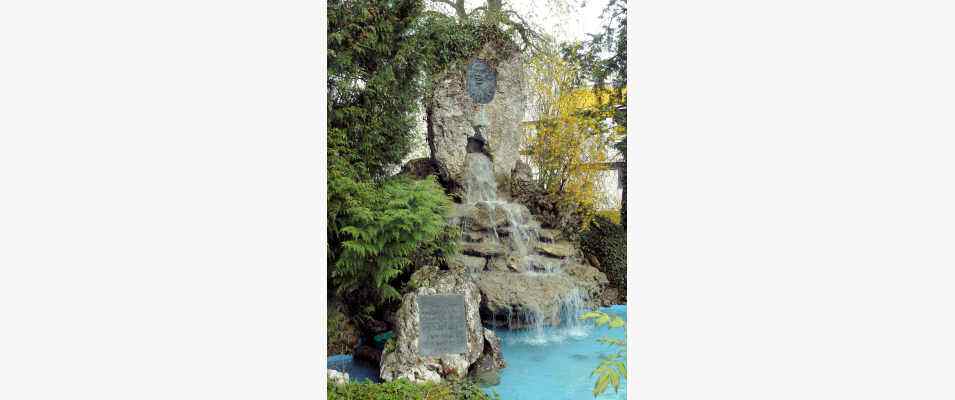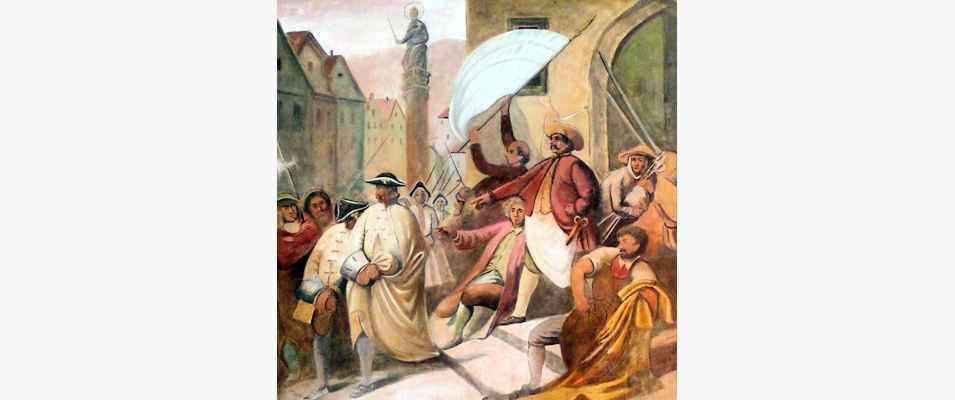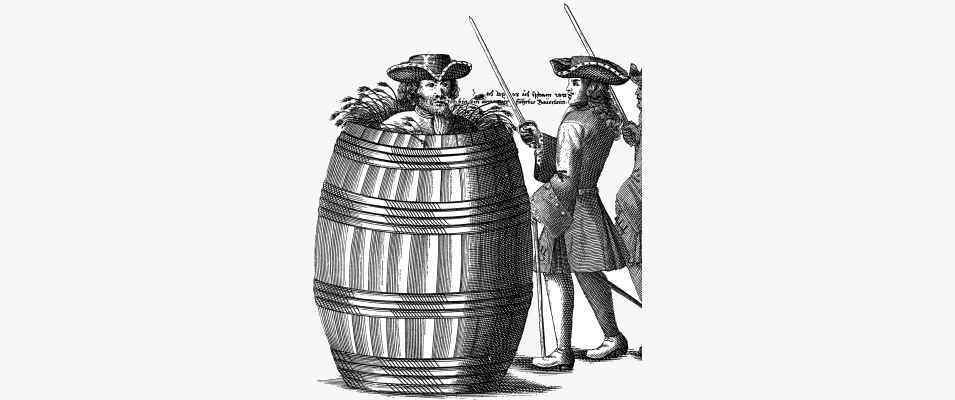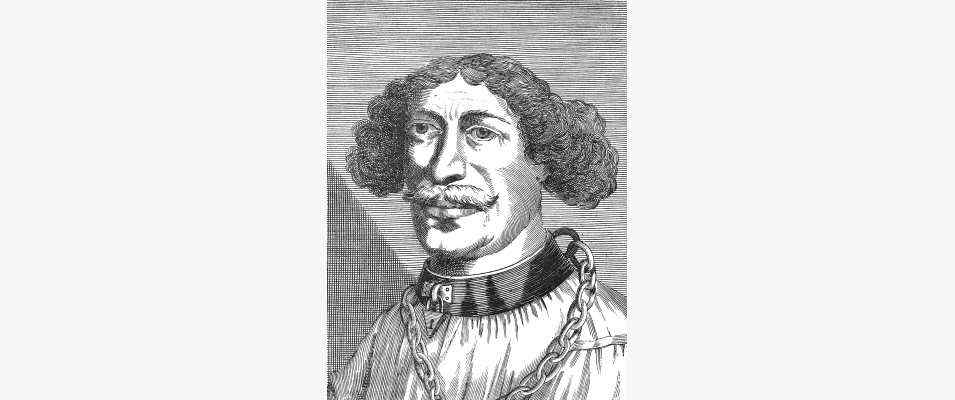




The Matthew Kraus Memorial
in Kelheim in the national park Altmuehl valley
Near the door of the pleasure grounds there is the memorial dedicated to Kraus, the courageous citizen of Kelheim, and to his brave followers. His picture is on top of a group of erratic blocks heaved in pyramid shape. A bronze plate reads:
1705
Kelheim and the Danube district
to the heroic citizen Matthew Kraus
and his fellow combatants
1905
The Kraus uprising
In the War of the Spanish Succession, the treaty of Ilbersheim, signed on November 7th, 1704, pledged all Bavarians to hand over the fortified places to the Austrian Army. On November 18th the Bavarian armed forces left Kelheim, and Austrian troops under the command of Captain Wexner marched in. And they were to stay there for a long time. In the course of time, arrogance and insolence on the side of the occupiers grew and became unbearable. Eventually young men were forced to serve in the Austrian Army. That was the last straw. Soon riots began. Young men fled the district and hid in the forests. A leader in the uprising was Matthew Kraus, a master butcher. He gathered a lot of discontented people. On November 15th, 1705, he made a sudden attack at Captain Wexner. The Austrians, however, defended themselves bravely and Kraus had to flee. Kraus went to Braunau, and in the headquarters of the Bavarian Army he was given a Captains s commission. After that, Kraus gathered a defence force of 200 men and marched back to Kelheim. A number of discontented young men joined his troop. In the night of December 13th, 1705, he reached Kelheim with his company. They swam across the mill-brook and entered the town through a small door in the brewery. So they could surprise the sleeping Austrian soldiers, and they took them all prisoners. Kraus declared himself commanding officer of Kelheim. In the town-hall he showed his commission and ordered all citizens to guarantee allegiance and support.
Kraus´s rule, however, did not last very long. A traitor secretly gave information about what had happened to the Austrian Colonel Truchsess, who was encamped with his regiment in Ingolstadt, about thirty miles away from Kelheim.
The colonel reinforced his troops and marched to Kelheim. He managed to take his enemies by surprise. The rebels of Kelheim were hopelessly hemmed in. Kraus wanted to fight, but a large number of citizens feared destruction and looting, and therefore they wanted to surrender. A priest was sent to negotiate. The Austrians reluctantly promised to allow Kraus and his men honourable retreat and to grant the citizens pardon.
In the afternoon of December 18th, 1705, while negotiations were still going on, the door of Middle Gate was opened and Kraus´s men were ready to march off. No sooner had the Austrians passed the door than they rushed upon the unsuspecting Kelheimers and began a massacre. People were knocked down, stabbed or pierced, strangled or stifled, shot and slain ruthlessly. Even those were slaughtered who tried to flee to churches. The ransacking of the town went on for hours. When the bloodthirsty raiders stopped, they did not find Kraus in the rows of the slain or mutilated nor did they see him among the prisoners.
Kraus had managed to hide in a cellar. After three days he was found and put in irons. In a miserable cart they brought him to the headquarters in Ingolstadt where he was penalized and tortured. The death-sentence was pronounced. His followers, many of whom had been dragged to Ingolstadt, were to be literally decimated, i. e. they had to cast lots and every tenth was to be executed. The fortifications of Kelheim were to be dismantled and Kraus´s house was to be pulled down. On March 16th, 1706, they threw Kraus who was in heavy chains on a knacker´s cart and transported him to Kelheim where the sentence was to be carried out. They told him that "by an unusual act of grace" he was to be decapitated first, afterwards quartered and finally be hanged in quarters at the gates and his head stuck on a pole. Fortunately the newspaper, a monthly magazine, has been preserved which gave a long description of the execution on March 17th. The hangman dragged Kraus to the townhall where the clerk of the court read the sentence in the presence of several hundred people. Kraus was declared guilty of a lot of crimes: He had used his money and money extorted from priests to hire a number of idle rogues. And with these rascals he had usurped power in the town and thus made a most vicious rebellion against His Imperial Majesty. Once more the clerk described what was going to be done with the man.
Two friars, praying incessantly, went with him to the place of the execution. There Kraus prayed and confessed and received absolution. Then he bade a quick blow. The executioner swung his dreadful sword mightily, and with one blow Kraus was beheaded.
Afterwards the Franciscans praised him blessed because he had the chance to confess and get absolution whereas hundreds of Kelheimers had been stabbed, drowned, shot or killed otherwise amidst their sins.
After the ordeal of Kraus, hatred was on the wane. There were petitions of review and petitions of clemency. The Bavarian court lodged a protest against the breach of contract and the atrocities committed when the Austrians recaptured Kelheim.
The victorious Austrians pardoned the men who had fought on Kraus s side. Only Kraus´s closest friend was scourged and exiled. Of the fortifications of Kelheim only one round tower and one square tower were pulled down. Kraus´s house was spared, and after some months his widow was given back all property.
In Kelheim mass was celebrated for the dead of December 18th and for Kraus.
back to the Homepage of the town Kelheim ![]()
Zuletzt aktualisiert am 10.02.2017